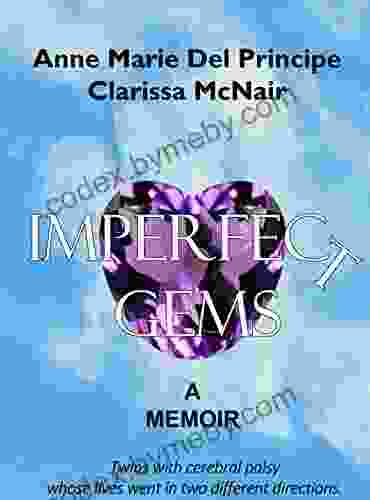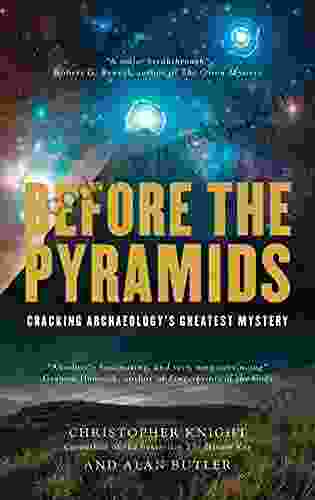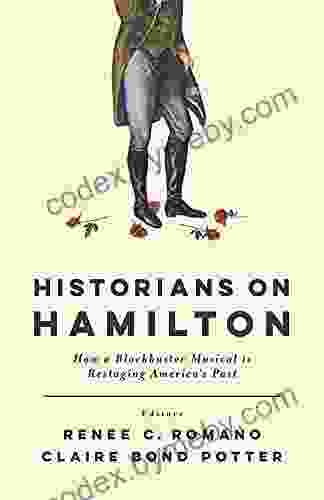Before The Pyramids: Cracking Archaeology's Greatest Mystery

Have you ever wondered who built the pyramids and why? What was the purpose of these massive structures? For centuries, these questions have stumped archaeologists and historians alike. But now, a groundbreaking book is offering a new theory that challenges everything we thought we knew about the pyramids.
4.2 out of 5
| Language | : | English |
| File size | : | 972 KB |
| Text-to-Speech | : | Enabled |
| Screen Reader | : | Supported |
| Enhanced typesetting | : | Enabled |
| X-Ray | : | Enabled |
| Word Wise | : | Enabled |
| Print length | : | 356 pages |
Before The Pyramids: Cracking Archaeology's Greatest Mystery, by Robert Bauval, presents compelling evidence that the pyramids were built not as tombs, but as astronomical observatories. Bauval, a world-renowned Egyptologist, has spent years studying the pyramids and the surrounding area. He has uncovered a wealth of evidence that supports his theory, including:
- The pyramids are aligned with the stars.
- The pyramids contain chambers that were used to observe the stars.
- The pyramids were built using advanced astronomical knowledge.
Bauval's theory is a major breakthrough in Egyptology. It challenges the traditional view of the pyramids and offers a new understanding of their purpose. Before The Pyramids is a must-read for anyone interested in ancient Egypt, archaeology, or the mysteries of our past.
Who is Robert Bauval?
Robert Bauval is a world-renowned Egyptologist and author. He is best known for his work on the Orion Correlation Theory, which proposes that the pyramids of Giza were built to reflect the constellation Orion. Bauval has also written extensively on other aspects of ancient Egypt, including the pyramids, the Sphinx, and the Temple of Karnak.
Bauval's work has been praised by many in the Egyptology community, but it has also been criticized by some. Some critics have argued that Bauval's theories are too speculative and that he does not provide enough evidence to support them. However, Bauval's work has also inspired a new generation of Egyptologists to look at the pyramids in a new way.
What is the Orion Correlation Theory?
The Orion Correlation Theory is a theory that proposes that the pyramids of Giza were built to reflect the constellation Orion. The theory was first proposed by Robert Bauval in the 1990s, and it has since gained a following among some Egyptologists.
The Orion Correlation Theory is based on the following observations:
- The three pyramids of Giza are aligned with the three stars of Orion's belt.
- The fourth pyramid at Giza, the Great Pyramid, is aligned with the star Sirius.
- The Sphinx is aligned with the constellation Leo.
Bauval argues that these alignments are not coincidental, but that they were intentionally designed by the ancient Egyptians. He believes that the pyramids were built as a giant astronomical observatory, and that they were used to study the stars and planets.
The Orion Correlation Theory is a controversial theory, and it has been criticized by some Egyptologists. However, it is a theory that has captured the imagination of many people, and it has helped to spark a new interest in the pyramids of Giza.
What is the evidence for the Orion Correlation Theory?
There is a growing body of evidence that supports the Orion Correlation Theory. This evidence includes:
- The pyramids of Giza are aligned with the stars with great accuracy. The alignment is so precise that it is unlikely to be coincidental.
- The pyramids contain chambers that were used to observe the stars. These chambers are located at specific points within the pyramids, and they offer clear views of the night sky.
- The ancient Egyptians had a sophisticated knowledge of astronomy. They were able to track the movements of the stars and planets, and they used this knowledge to create calendars and predict eclipses.
Taken together, this evidence suggests that the pyramids of Giza were built as an astronomical observatory. The ancient Egyptians used the pyramids to study the stars and planets, and they used this knowledge to gain a deeper understanding of the universe.
What is the significance of the Orion Correlation Theory?
The Orion Correlation Theory is a significant theory because it challenges the traditional view of the pyramids of Giza. Traditionally, the pyramids have been seen as tombs, but the Orion Correlation Theory suggests that they were actually built as an astronomical observatory. This theory has implications for our understanding of ancient Egypt and the ancient Egyptians.
The Orion Correlation Theory suggests that the ancient Egyptians were more advanced than we thought. They had a sophisticated understanding of astronomy, and they were able to use this knowledge to build a giant astronomical observatory. This theory also suggests that the pyramids were not built for religious purposes, but for scientific purposes. This is a major shift in our understanding of the pyramids, and it has opened up new avenues of research.
The Orion Correlation Theory is a controversial theory, but it is a theory that has captured the imagination of many people. It is a theory that is supported by a growing body of evidence, and it is a theory that has the potential to change our understanding of ancient Egypt and the ancient Egyptians.
4.2 out of 5
| Language | : | English |
| File size | : | 972 KB |
| Text-to-Speech | : | Enabled |
| Screen Reader | : | Supported |
| Enhanced typesetting | : | Enabled |
| X-Ray | : | Enabled |
| Word Wise | : | Enabled |
| Print length | : | 356 pages |
Do you want to contribute by writing guest posts on this blog?
Please contact us and send us a resume of previous articles that you have written.
 Book
Book Novel
Novel Page
Page Chapter
Chapter Text
Text Story
Story Genre
Genre Reader
Reader Library
Library Paperback
Paperback E-book
E-book Magazine
Magazine Newspaper
Newspaper Paragraph
Paragraph Sentence
Sentence Bookmark
Bookmark Shelf
Shelf Glossary
Glossary Bibliography
Bibliography Foreword
Foreword Preface
Preface Synopsis
Synopsis Annotation
Annotation Footnote
Footnote Manuscript
Manuscript Scroll
Scroll Codex
Codex Tome
Tome Bestseller
Bestseller Classics
Classics Library card
Library card Narrative
Narrative Biography
Biography Autobiography
Autobiography Memoir
Memoir Reference
Reference Encyclopedia
Encyclopedia Christopher G Worley
Christopher G Worley Joanna Kujawa
Joanna Kujawa Gary Richter Dvm
Gary Richter Dvm John Porcellino
John Porcellino Christina Wilsdon
Christina Wilsdon Christopher J Lebron
Christopher J Lebron John Preston
John Preston Emily Chetkowski
Emily Chetkowski Leslie Scrivener
Leslie Scrivener Sarah Waters
Sarah Waters Christopher E Mason
Christopher E Mason Peter R Mansoor
Peter R Mansoor Victoria Tennant
Victoria Tennant Chris Enss
Chris Enss Prof John Chao
Prof John Chao Jeff Vandermeer
Jeff Vandermeer David Helvarg
David Helvarg Jocko Willink
Jocko Willink Jordan Christy
Jordan Christy Manveen Kaur
Manveen Kaur
Light bulbAdvertise smarter! Our strategic ad space ensures maximum exposure. Reserve your spot today!

 Joseph HellerUnveiling the Secrets to Settling Your Insurance Claim: A Comprehensive Guide...
Joseph HellerUnveiling the Secrets to Settling Your Insurance Claim: A Comprehensive Guide...
 Johnny TurnerRaised By Wolves: Predators MC – Witness the Raw and Unforgettable Journey...
Johnny TurnerRaised By Wolves: Predators MC – Witness the Raw and Unforgettable Journey... Julio Ramón RibeyroFollow ·2.6k
Julio Ramón RibeyroFollow ·2.6k Federico García LorcaFollow ·4.9k
Federico García LorcaFollow ·4.9k Heath PowellFollow ·3k
Heath PowellFollow ·3k Bill GrantFollow ·3.6k
Bill GrantFollow ·3.6k Vernon BlairFollow ·12.4k
Vernon BlairFollow ·12.4k F. Scott FitzgeraldFollow ·12.9k
F. Scott FitzgeraldFollow ·12.9k Glen PowellFollow ·16.9k
Glen PowellFollow ·16.9k Pat MitchellFollow ·10.8k
Pat MitchellFollow ·10.8k

 Rick Nelson
Rick NelsonThe Power of Positivity: 51 Motivational Quotes to...
In the tapestry of life, we encounter...

 Lee Simmons
Lee SimmonsThe Indian War of 1864: A Devastating Conflict in the...
The Indian War of 1864 was a brutal...

 Eddie Bell
Eddie BellQueen: The Unauthorized Biography: Unraveling the Secrets...
Prepare to delve into the captivating...

 Dion Reed
Dion ReedUnveiling the Imperfect Gems of Trauma and...
In the tapestry of...

 Desmond Foster
Desmond FosterThirty-Six Years in the Rockies: A Timeless Masterpiece...
A Journey Through Time and...
4.2 out of 5
| Language | : | English |
| File size | : | 972 KB |
| Text-to-Speech | : | Enabled |
| Screen Reader | : | Supported |
| Enhanced typesetting | : | Enabled |
| X-Ray | : | Enabled |
| Word Wise | : | Enabled |
| Print length | : | 356 pages |










